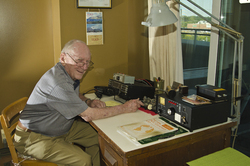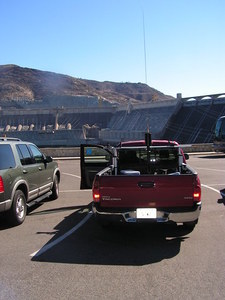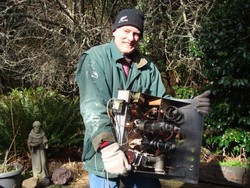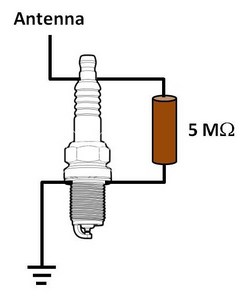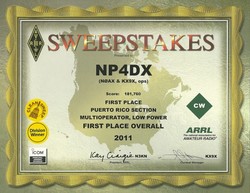 September 26, 2012 Editor: Ward Silver, NØAX | ||||||||
IN THIS ISSUE
NEW HF OPERATORS - THINGS TO DO Here comes a pair of major state QSO parties - the Texas QSO Party is this coming weekend and the California QSO Party is the following weekend. These are great contests for new HF operators in North America - both are domestic (meaning modest stations do quite well) and there is enough activity to keep the weekend interesting without intense crowding. You may also hear some Chinese stations mixed in with the Californians - this is the weekend for the Worked All Provinces of China contest - the first-ever Chinese DX contest! BULLETINS There are no bulletins in this issue. BUSTED QSOS K3EST has been a member of the WRTC Sanctioning Committee for 16 years, not 26. Your editor is losing his ability to subtract, apparently. (Thanks, Bob W6RGG) The QST edition of Contest Corral for September should have listed the CQ WW RTTY Contest and Texas QSO Party as starting on Sept 29th. The online PDF version is correct. (Thanks, Dick WØRAA) CONTEST SUMMARY Complete information for all contests follows the Conversation section Sep 29-30
Oct 6-7
The World Wide Radio Operator Foundation (WWROF) has assumed sponsorship of the popular PVRC Webinar series beginning with "A Look at the Upcoming PA & CA QSO Parties". PA QSO Party chairman Mike Coslo N3LI and CA QSO Party representative John Miller K6MM will provide an overview of their upcoming QSO parties. The webinar will be presented on Monday, Oct 1 at 9 PM EDT and registration is free as always. (Thanks, Ken K4ZW)
This year's package of Sweepstakes information (rules, records, writeups, forms, etc) is now available online at the ARRL Sweepstakes web page. This is a great introduction and reference to the oldest of the domestic contests, held on the first and third weekends of November. (Thanks, Sean KX9X) All 58 California counties should on the air during the upcoming California QSO Party as shown in this activity map/cheat sheet. There are also some new club contesting rules designed to (1) encourage county expeditions and mobile operations in the rarer California counties and (2) to clarify how proportional points are awarded for club totals when a club member participates in a multi operation. In addition, Ontario (VE3, not the southern California city) remains a single multiplier for CQP. The partition of Ontario into four different RAC sections does not affect CQP scoring. (Thanks, Bob N6TV and Alan K6SRZ) The web site for the Stew Perry Top Band Distance Challenge has been successfully moved to its new host, just in time for the Oct 20/21 Stew Perry Warmup. (Thanks, Tree N6TR) Also on October 20-21, Jamboree on the Air (JOTA) is getting closer. The Scouting website has been updated with a great deal of supporting content. They have also just posted a promotional video directed at hams letting them know what it is and how to get involved. Right on the heels of School Club Roundup during the preceding weekdays, JOTA is a great opportunity to introduce ham radio to kids and young adults. (Thanks, National Jamboree on the Air Organizer, Jim K5ND)
From the AMSAT News Service bulletin ANS-260 comes an article that discusses how CubeSats have captured the attention of space agencies and universities world-wide due to the significant amount of science that can now be packed aboard. If you sometimes use paper to log contest contacts, Charlie KX7L reports, "For turning old paper logs into ADIF, I've used something called Fast Log Entry (FLE) by DF3CB. It's very simple. You enter the date, mode and band once and they stay the same for subsequent QSOs until you change it. Then just enter time and call for each QSO. You don't even need to enter the whole four digits of time, just the minutes will do if that's all that changed. It's free and simple. ADIF2CABR, by SP7DQR looks pretty good (converting ADIF to Cabrillo format). You can pick which ADIF fields get converted into the Sent and Received exchanges. If you enter the received mult as a comment in FLE (enter '#' after the call, then the comment) then you can tell ADIF2CABR to use the CMT field." Web Site of the Week - Stanford Magazine recently featured a great article, "Members Make Waves", about the W6YX club, perched high in the hills above the Palo Alto campus. In an interview, the club's current trustee, Dave W6NL, recounts some of the club's history which includes famous names like Packard, Villard, and Terman. (Thanks, Steve K6AW and Bob N6TV) WORD TO THE WISE 3830 - what is this 3830 business, anyway? Before the web, there was 75 meters. After the contest participants would gather near 3830 kHz to exchange scores, excuses, and embellishments. The collected scores would then wend their way through the contest community by various media. An email reflector named "3830" was created by Trey N5KO (then WN4KKN) in the early-1990s, the name recognizing the over-the-air, post-contest watering hole. A few years later, Bruce WA7BNM created a claimed-score reporting website that sent collected information to the email reflector and Dink N7WA added the score compilations, completing the electronic claimed-score posting system we all use today. One very interesting story of examples of how ham radio has proven to be significant in technology and politics is this video story of the Lithuanian revolt and QSOs with the ham station in the parliament building that helped keep the world informed. (Thanks, Dave W6NL)
The Van Allen Belts - regions of high-energy charged particles trapped in the Earth's magnetic field - live up above the ionosphere. Learn more about these interesting features of our planet's immediate vicinity in this NASA Earth Observatory article. Things get a little scary around the 1-minute mark in this controlled demolition video of a tower being dropped in place. Just before the 2-minute mark, watch the antenna at the top waving "bye-bye"! (Thanks, Tim K3LR) â2011 ARRL EME Contest certificates went out the door recently. CW Sweepstakes certificates will be following them today (Wednesday) and Phone Sweepstakes certificates shortly thereafter, just in time for motivating you during this year's contests! You'll like the return of the stickers including the new post-adjudication Clean Sweep stamp as seen in the Conversation section! Plaques will be shipping soon, too. (Thanks, ARRL Contest Branch Manager, Sean KX9X) The preliminary results for the September CW Sprint are now posted online. Congratulations to Trey N5KO on another victory. (Thanks, CW Sprint Manager, Tree N6TR)
Results for the 2011 running of the Arizona Statehood QSO Party are now online for your viewing pleasure. Plaques and certificates will be following shortly! The 16th Amateur Radio Direction Finding World Championships were recently held in Serbia. The USA team really stepped up this time, bringing home 13 medals, including the first-ever American gold medals! ARDF, quite popular around the world, has been attracting more and more attention stateside - watch for more ARDF action in your area or help your club sponsor an event! OPERATING TIP Contest Elbow - that painful outcome of resting your arm on the elbow while you tune the radio for a long contest. Veteran of many hours at the rig, Ken K6LA/VY2TT suggests, "The best solution for forearm soreness problems is football elbow pads. I cut the cloth lengthwise and add Velcro straps across the pads to keep them on but loose enough to be comfortable." Game on! As the fall contest season continues to ramp up to full intensity, there has been lots of discussion about table height for contesting. Most tabletops are placed 29-31 inches from the floor but always seem just a little "too" one way or the other. The solution may lie right under you - in an adjustable chair. A small footrest can go a long way towards improving operator comfort as well. Gary K9GS identified an alternate solution, "You can buy very heavy duty adjustable leveling feet that will give you several inches of adjustment. Again Google is your friend but you can probably start with Rockler, Woodcraft, or Lee Valley to find what you need." Jim K8MR has "...installed a slide-out keyboard shelf which rests the keyboard 24 inches above the floor. This works out to be almost literally in my lap." He also suggests, "Use a chair without arms, or at least a chair wide enough that you can drop your arms by your side without using the arm rests. It is much more relaxing...(and)...your wrists will not be bending sideways. Have enough extra cables on your radios that you can slide them to the very front edge of desk. With this, there is only an inch or two of forward motion required to move between the keyboard and the radio...(or)...radios can also be shoved back to a more conventional position, with your arms resting on the desktop. Change of position is always a good thing." He also notes that armless chairs help you stay awake! Many counties provide the National Electrical Code (NEC) as a downloadable PDF file such as this 2008 version, since it is written into their inspection code requirements. (Thanks, Steve W3AHL) A tale of telephone RFI on 10 meters from Eddy VE3CUI/VE3XZ recounts his amazement of discovering that "the coiled handset cord while I was seated was immune to RFI but as soon as it was outstretched, it must have acted like a resonant (antenna) on 10 meters!" It just goes to show that anything can act as an antenna - either receiving or transmitting!
The graphic at right shows a method of draining charge from an antenna while also providing some protection against high voltages from static electricity. The basic idea is presented on the K2AV Folded Counterpoise antenna website. The value of the 5-Mohm resistor is not critical and just needs to be high enough to minimize its effect on antenna impedance while surviving normal operation. Power ratings of 2 watts or better are generally recommended in this application. The spark plug can be mounted directly to a grounded plate, as well. Based on some reasonable assumptions about converting materials into cost-per-dB, Tom W8JI came up with a reasonable order of progression for low-band station builders:
Dave K6LL reminds us of a method for testing coax loss even with an antenna connected. It takes advantage of an antenna's likelihood of presenting a high-impedance at some out-of-band frequency to act as a nearly open circuit. Dave presents a formula for converting the resulting SWR into line loss. The lower the SWR at the high-impedance frequency, the higher the loss. Along with VE3CUI's discovery on transmitting RFI, Dale K9VUJ also discovered that receiving RFI can be caused by anything. "I myself a few years ago had a random sporadic noise, crackling and very strong especially on the lower bands. One day I had the receiver volume turned up so I could hear it in another room and while I was walking though the kitchen I heard the "crackle crackle" while I walked. I went to the basement and started looking all around. What I found was the metal wire that is used to hang suspended ceiling tile was barely touching a metal electrical conduit above the tile and any amount of vibration would cause static in the radio."
The round "flip-top" containers for chewing gum lozenges make great small-parts holders for toolboxes and on the workbench. The labels peel right off so you can easily see what's inside and the small flip-up hatch makes it easy to get out one part at a time. What is the worst radio location in the world? Well, it's not actually on this world, according to the Popular Science article "Satellite Radio" in the October 2012 issue. The worst place turns out to be on the dark side of the Moon but the noise floor is really, really low! Technical Web Site of the Week - 3D printing is a technology that is going to be increasingly common in ham radio as evidenced by this Makezine review of 15 different consumer-grade 3D printers. Consider that just a few years ago, these were high-end industrial products costing five figures and up. Now we have "consumer grade" and more than a dozen available plus online plans for building your own. (Photo of Charlotte hamfest) Lowering the Broom Not to mix a metaphor or anything but there is a lot of low-hanging fruit to be swept up in this year's ARRL November Sweepstakes. The contest's manager, Larry Hammel K5OT observes that we will "be surprised at the number of opportunities that exist in both modes on the all-time records list!" Of course, there are the four new Ontario sections to push the top scores up by three more multipliers - a built-in bonus of nearly four percent! The two new Low-Power categories added in 2011 still have 111 section-level records unclaimed in Multi-op, Low Power and 54 in Unlimited, Low Power. (That includes both Phone and CW.) Where there is really a lot of opportunity is in the School Club category. At the section level, there are 49 CW records for which an entry has never even been submitted and 31 on Phone! Don't you have a high-school or college club nearby that might like to claim a record of their own? Even if the club is not formally organized, the multi-operator categories are wide open. Larry has done quite a bit of review in the Sweepstakes records and you'll see a more extensive article by him in the upcoming issue of the National Contest Journal. In the meantime, a visit to the online records would certainly be in order, don't you think?
Speaking of those clubs, you have some great opportunities to motivate some young radio aficionados with the School Club Roundup on October 15-19 that is followed by Jamboree On The Air (JOTA). Invite some of these potential hams to your shack for a few hours of radio time and see if a few of them might not like to put in a few hours during Sweepstakes. A challenge with another local group is a good motivator, too! I also recommend a post-contest pizza party. For personal efforts, shooting for a record is a great way to stay engaged throughout the contest and fight off fatigue. Make an hour-by-hour chart of your best effort, then add the record line and see how close you can get this year. Maybe you'll be able to add your own call sign to the list. A note to contest managers - if your club sponsors a contest, be sure to keep your record list up to date. It attracts participation and makes the results more interesting when you can talk about new records being set. The unique "clean sweep" of Sweepstakes multipliers has always been represented by "the broom". Many a time, a station is one of the rarer sections will hear "Thanks for the sweep!" as a final section is logged and checked off the list. The new clean sweep stickers are also being added to Sweepstakes certificates this year - maybe you'll see one in your mailbox soon? Why not hand out specially-decorated brooms to your club's high achievers? It makes a great program event at the annual holiday party! Crossing off each section as you log them is one of contesting's great traditions, whether you are computer logging or not. The list was printed at the bottom of the paper entry forms - it was great to send in a log with all sections marked off! The excitement of the new Ontario sections, expectations for high-band activity, and a whole raft of records within reach should have every broom-wielding clean sweep mug chaser counting the days to the first and third weekends in November. Let's lower our brooms to the noise floor and get to work! 26 September through 9 October An expanded, downloadable version of QST's Contest Corral in PDF format is available. Check the sponsor's Web site for information on operating time restrictions and other instructions. HF CONTESTS SKCC Straight Key Sprint--CW from Sep 26, 0000Z to Sep 26, 0200Z. Monthly on the 4th Wednesday UTC. Bands (MHz): 1.8-28, 50. Exchange: RST, QTH, name, SKCC nr or power. Logs due: 5 days. Rules CQ WW RTTY Contest--Digital from Sep 29, 0000Z to Sep 30, 2400Z. Bands (MHz): 3.5-28. Exchange: RST, CQ zone and State/VE area (US/VE). Logs due: Nov 1. Rules Texas QSO Party--Phone,CW,Digital from Sep 29, 1400Z (multiple operating periods, see website). Bands (MHz): 1.8-28, 50,144, Frequencies (MHz): CW--20 to 50 kHz above band edge; Phone--25 kHz above edge of General segment. Exchange: RS(T), county or S/P/C. Logs due: Oct 31. Rules ARS Spartan Sprint--CW from Oct 2, 0200Z to Oct 2, 0400Z. Monthly on the first Monday evening local time. Bands (MHz): 3.5-28. Exchange: RST, S/P/C, and power. Logs due: 2 days. Rules OK1WC Memorial Contest--Phone,CW from Oct 2, 1600Z (see website). First through fourth Monday of each month. Bands (MHz): 3.5, 50, 144, see website for bands. Exchange: RS(T) and serial. Logs due: 7 days. Rules http://www.hamradio.cz/ok1wc SNS and NS Weekly Sprints--CW,Digital from Oct 5, 0200Z to Oct 5, 0300Z. Weekly on Thursday evenings local time. Bands (MHz): 1.8-14. Exchange: Serial, name, and S/P/C. Logs due: 2 days. Rules DX/NA YLRL Anniversary Party--Phone,CW,Digital from Oct 5, 1400Z to Oct 7, 0200Z. Bands (MHz): 1.8-28. Exchange: Serial, RST, and section/province/country. Logs due: 30 days. Rules PSK Rumble - The Fall Classic--Digital from Oct 6, 0000Z to Oct 6, 2400Z. Bands (MHz): 1.8-28, 50. Exchange: Name and call area (see website). Logs due: Oct 31. Rules Worked All Provinces of China--Phone,CW from Oct 6, 0000Z to Oct 6, 2359Z. Bands (MHz): 3.5-28. Exchange: RS(T) and serial or province abbreviation. Logs due: Oct 31. Rules EPC Russia DX Contest--Digital from Oct 6, 0400Z to Oct 7, 0359Z. Bands (MHz): 1.8-28. Exchange: EPC member nr or serial and grid square. Logs due: Oct 22. Rules Oceania DX Phone Contest--Phone from Oct 6, 0800Z to Oct 7, 0800Z. Bands (MHz): 1.8-28. Exchange: RS and serial. Logs due: Nov 7. Rules Worked All Britain HF Contest--Phone from Oct 6, 1200Z to Oct 7, 1200Z. Bands (MHz): 14-28. Exchange: RS, serial, DXCC entity or WAB area. Logs due: Oct 28. Rules California QSO Party--Phone,CW from Oct 6, 1600Z to Oct 7, 2200Z. Bands (MHz): 1.8-28, 50,144. Exchange: Serial and state/prov/"DX" or CA county. Logs due: Oct 31. Rules EU Autumn Sprint--Phone from Oct 6, 1600Z to Oct 6, 1959Z. Bands (MHz): 3.5-14. Exchange: Both call signs, serial, name. Logs due: 15 days. Rules RSGB 21/28 MHz Contest--Phone,CW from Oct 7, 0700Z to Oct 7, 1900Z. Bands (MHz): 21,28. Exchange: Serial and UK district. Logs due: Oct 22. Rules VHF+ CONTESTS ARRL EME Contest--Phone,CW,Digital from Oct 6, 0000Z to Oct 7, 2359Z. Bands (MHz): 2.3G+. Exchange: Call signs, sig rpt, acknowledgement. Logs due: Jan 1. Rules 902 MHz Fall VHF Sprint--Phone,CW,Digital from Sep 29, 7 AM to Sep 29, 1 PM. Bands (MHz): 902+. Exchange: 6-character grid locator. Logs due: 4 weeks. Rules 432 MHz Fall VHF Sprint--Phone,CW,Digital from Oct 3, 7 PM to Oct 3, 11 PM. Bands (MHz): 432. Exchange: 4-character grid square. Logs due: 4 weeks. Rules Texas QSO Party--Phone,CW,Digital from Sep 29, 1400Z (multiple operating periods, see website). Bands (MHz): 1.8-28, 50,144, Frequencies (MHz): CW--20 to 50 kHz above band edge; Phone--25 kHz above edge of General segment. Exchange: RS(T), county or S/P/C. Logs due: Oct 31. Rules OK1WC Memorial Contest--Phone,CW from Oct 2, 1600Z (see website). First through fourth Monday of each month. Bands (MHz): 3.5, 50, 144, see website for bands. Exchange: RS(T) and serial. Logs due: 7 days. Rules PSK Rumble - The Fall Classic--Digital from Oct 6, 0000Z to Oct 6, 2400Z. Bands (MHz): 1.8-28, 50. Exchange: Name and call area (see website). Logs due: Oct 31. Rules California QSO Party--Phone,CW from Oct 6, 1600Z to Oct 7, 2200Z. Bands (MHz): 1.8-28, 50,144. Exchange: Serial and state/prov/"DX" or CA county. Logs due: Oct 31. Rules LOG DUE DATES 26 September through 9 October
ARRL Information Click here to advertise in this newsletter. Your One-Stop Resource for Amateur Radio News and Information ARRL membership includes QST, Amateur Radio's most popular and informative journal, delivered to your mailbox each month. Subscribe to NCJ - the National Contest Journal. Published bimonthly, features articles by top contesters, letters, hints, statistics, scores, NA Sprint and QSO Parties. Subscribe to QEX - A Forum for Communications Experimenters. Published bimonthly, features technical articles, construction projects, columns and other items of interest to radio amateurs and communications professionals. Free of charge to ARRL members: Subscribe to The ARRL Letter (weekly digest of news and information), the ARES E-Letter (monthly public service and emergency communications news), Division and Section news -- and much more! ARRL offers a wide array of products to enhance your enjoyment of Amateur Radio. Visit the site often for new publications, specials and sales. Donate to the fund of your choice -- support programs not funded by member dues! Reprint permission can be obtained by sending email to permission@arrl.org with a description of the material and the reprint publication. ACKNOWLEDGEMENTS ARRL Contest Update wishes to acknowledge information from WA7BNM's Contest Calendar and SM3CER's Contest Calendar. | ||||||||
